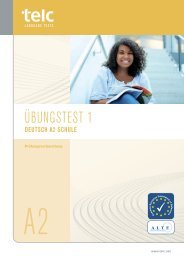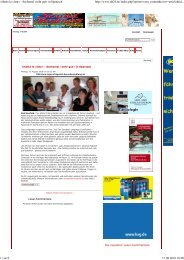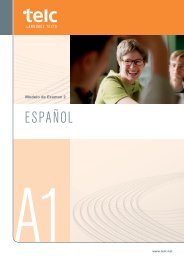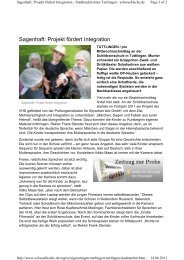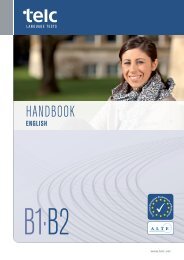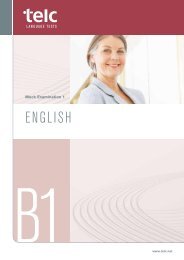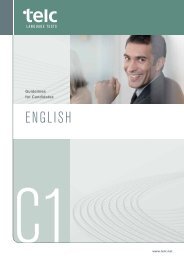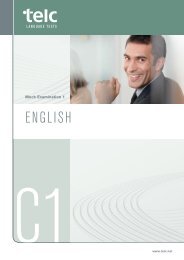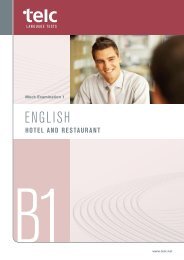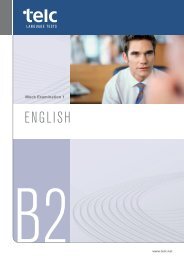Download Handbook (PDF, 4,3 MB) - telc GmbH
Download Handbook (PDF, 4,3 MB) - telc GmbH
Download Handbook (PDF, 4,3 MB) - telc GmbH
You also want an ePaper? Increase the reach of your titles
YUMPU automatically turns print PDFs into web optimized ePapers that Google loves.
Inventories<br />
3.2 Inventory G – Grammar<br />
The work on the compilation of the inventory of grammatical forms was based on a combination of<br />
a review of the existing literature on grammatical progression, a review of the practical application of<br />
progression theories to the development of language tests by examination boards in the UK, and finally<br />
through empirical research based on the judgements of expert teachers. This work, which began in<br />
2008, has informed a number of recent developments in the area of English language assessment<br />
over the past three years, most notably the International Language Assessment (ILA) a placement test<br />
system designed for use by the British Council’s international teaching centres, and the EQUALS/British<br />
Council Core Inventory for General English (North et al, 2010 – available at http://www.teachingenglish.<br />
org.uk/sites/teacheng/files/Z243 %20E&E %20EQUALS %20BROCHURErevised6.pdf).<br />
The absence of an empirically supported understanding of the details of grammatical progression in<br />
the research literature suggested that we should look instead to the practical application of progression<br />
in the materials and tests currently in use in the area. We were fortunate enough to receive support<br />
in this endeavour from City & Guilds of London, who had commissioned such a list in 2007 and who<br />
now made it available to CLARe researchers. This list was reviewed in light of current practice and a<br />
total of over 120 individual grammatical forms were identified and exemplified under sixteen headings.<br />
Using this document as a base, we then devised an online questionnaire, which was given to a group of<br />
twelve expert informants (senior teachers, each with many years of experience behind them) who were<br />
asked to identify the CEFR level or levels at which these forms should be taught. The results of this<br />
part of the study were analysed using multi-faceted Rasch analysis (using the FACETS programme) in<br />
order to empirically validate the judgements and the predictability of the judgements of the individual<br />
items. While it was found that some items could not be accurately modelled, suggesting that there was<br />
significant disagreement among the judges with regard to the items, the consistency of the judgements<br />
was remarkably high, with all those involved showing excellent ’fit’ statistics. This work resulted in a final<br />
list of forms, which was then again reviewed by an external expert, who commented additionally on the<br />
examples offered, making a number of valuable suggestions.<br />
As a result of this work, researchers at CLARe have been able to devise more empirically supported<br />
tests of grammar, and also to advise examination boards on those aspects of grammar which are most<br />
likely to appear at the different CEFR levels. This work is, of course, continuing. And, as we gather data<br />
from research projects and tests, the list will at some stage in the future be updated. However, the<br />
inventories that follow are based on the most up-to-date research undertaken at CLARe and mark a<br />
significant advancement in the application of grammatical progression to tests of this nature.<br />
3.2.1 Inventory G I – The Grammar of Spoken and Written Discourse<br />
4 Sentence Position<br />
A Theme<br />
b Tails<br />
5 Cohesion<br />
A Reference<br />
b Ellipsis<br />
C Substitution<br />
<strong>Handbook</strong> <strong>telc</strong> English A2·B1<br />
57



